(A video can be found at the bottom of this article.)
What a difference a year can make. Exactly a year ago, I sat at this very desk, typing up a story telling the world I was calling it quits on supercollecting Canseco. It was emotional for me, but the response & support were overwhelmingly positive. Little did I know that life was going to get infinitely more turbulent. Over the past year, many things in life have happened, primarily my dad passing away, missing him like crazy, having our new son, loving him like crazy and wishing the two could have met … all while feeling…well, crazy.
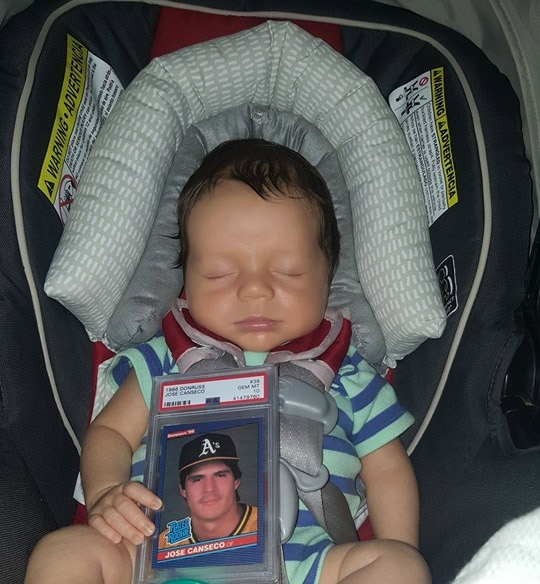
At times, we struggle to find a new normal in life. I cannot complain, because life is good, though at times quite emotional. I have a wonderful wife, and am raising practically two generations of kids under our roof, both of whom we are wild about. Yet, the tears still make an appearance from time to time for dad.
This hobby of ours has been a great distraction for me during the times that I have been down this past year. I have been on television and interviewed more times this past year than any other, and have met a ton of great people along the way!

Not being pigeon-holed into exclusively collecting one player has allowed me to immerse myself in the rich history of the hobby and the game, and fall in love with them all over again. I have been fairly quiet this year when it came to writing – in fact, I’ve probably written far less over the past year than any other since I started writing. Conversely, I’ve read more over about baseball and cards over the past year than any other.
A change in direction
When I was still a Canseco Supercollector, I would step back from time to time and muse about “what could have been”. What would my collection have looked like if I used the money I put into a single player, and spread it out into dream cards? I would dream of the possibility of having cards from the 19th century in my collection. The same went for players such as Mickey Mantle, Hank Aaron, Willie Mays, Babe Ruth, Ty Cobb, Honus Wagner & other all-time greats coming into my possession. The very thought of having genuine, authentic cards of baseball royalty from their playing days was intriguing to me. Not just that, but all of the different kinds of baseball cards we have been treated to over the past nearly 150 years. T206, 1952 Topps, Turkey Red, Goudey, Cracker Jack – all of these give me goose bumps.
Over the past year, I’ve been quietly putting together a collection / investment portfolio of vintage baseball cards. Many of them have dawned the covers of collectible magazines when I was growing up. The kinds of cards that would always make me think:
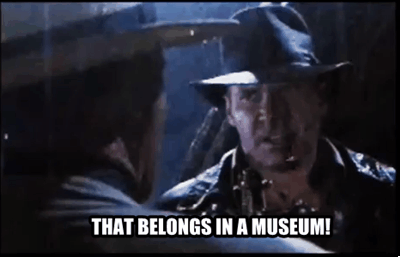
I wanted my new focus to tell as complete of a story as possible about the American pastime – I realize that if you have read through this much already, you don’t just want to see what I have picked up. You want to be entertained and educated. It is my hope that this story will do just that, with the aid of my new cards.
As I learned more about baseball history, I grew to love it more and more. Poor Holly & Atticus, though. They have had to endure many long-winded stories from me about baseball history over the past several months. Thankfully, now I have Beckett to tell them to, and he won’t roll his eyes 🙂
I’ll be honest, I was surprised by how intriguing baseball history is from the 19th century – and how little I knew. By the time the Civil War was over in 1865, Baseball was already considered America’s national pastime, though the ball was still pitched underhand until 1884.
As for the heart of my “new old” collection I focused on leveraging the term “buy the card, not the grade”. In other words, I targeted low to mid grade cards, with significantly better eye appeal than the grade suggests. Most of my acquisitions do not have bends, trimming issues or holes, but may have back damage or rounded corners. Eye appeal was of the utmost importance to me, which sometimes meant going for an altered card over a numerically low grade. It’s amazing how eye appeal for a 1 or 2 can vary so drastically. Take for instance the 2 pictured below. No doubt, the one on the right would grade a poor just like the one on the left, which appears to be pack fresh, aside from some back damage. For me, it is all about presentation, and not about the numerical grade.
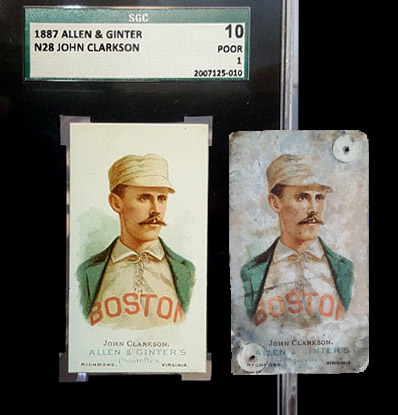
19th Century Baseball Cards
We are going to start with some cards that are over 20 years older than T206 cards. I still run into people that didn’t even know baseball cards existed in the 19th century. If you think the first legitimate baseball card craze happened in the 1980s, you would be off by almost exactly 100 years. Cigarette makers started creating baseball cards out of the stiffeners that were in their boxes as collectible advertising pieces – and kids were wild about them. Some of the baseball cards would fetch up to a quarter, which adjusted for inflation today, is nearly $7. The dangers of cigarette smoking was known of in the 19th century, yet kids could be seen buying packs and smoking them. Check out this crazy advertisement from Old Judge!
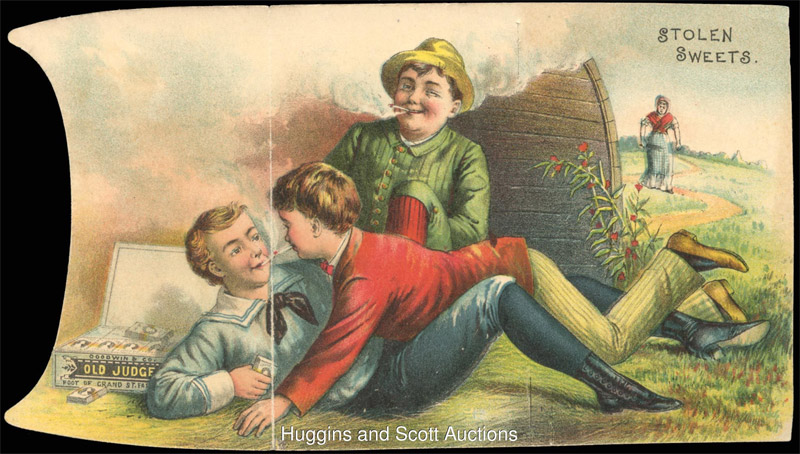
1887-1890 Old Judge (N172)
Back in the 1800s, advertisements on paper such as the one above were called “trade cards”, and often featured beautiful lithography, die-cuts and quirky artwork. From advertisements for sewing machines to medicine, no matter the advertisement, many people would collect them, keeping them in albums. Old Judge started inserting cards with photographs of baseball players in their cigarette boxes. Seeing actual photographs of your favorite players back then would be akin to meeting them today. Photography itself was in its infancy around this time, and was very much so a novelty. Keep in mind, during this time, things like the automobile, telephones and even electricity were still a long ways off from being staples in households. To put things even more into perspective, the makers of Old Judge baseball cards had previously funded a trip for the California Gold Rush before the Civil War!
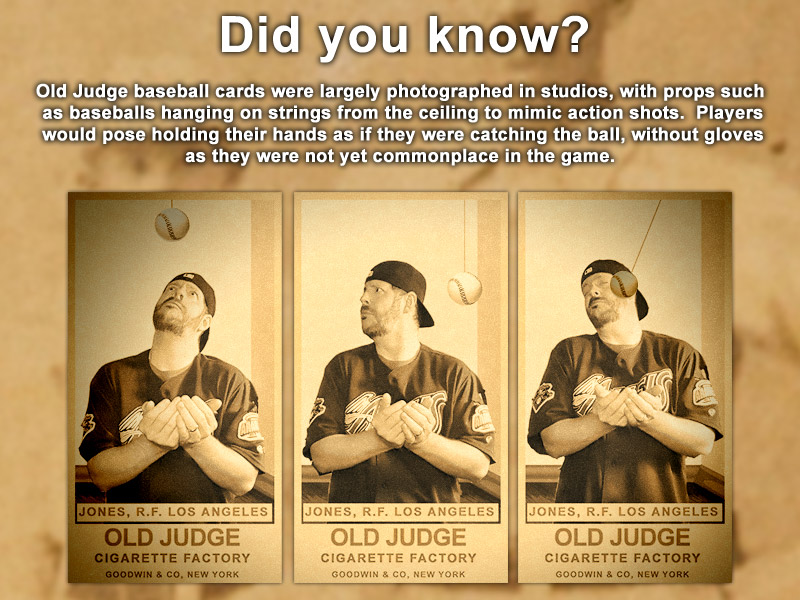
Old Judge was among the first comprehensive set of baseball cards to utilize actual photographs of single players. With over 500 known subjects and over 2,400 known different cards (many players have several poses), it is a gigantic set, and would simply be impossible to complete. All but the 1887 Brooklyn and rare 1889 California League cards were photographed in a studio setting. They mimicked “action” shots by having the players pose with their hands open, ready to catch a ball that was suspended by a string from the ceiling. Other photos included players posing as if a play was being made, and still others posed with mascots. Crude bases and grass might have been mimicked by newspaper, pillows, rugs and other items on a studio floor, with players posing many times in front of illustrated backdrops.
With Old Judge cards, I am extremely lenient about corners, edges and writing on the backs of them. My main concern is the clarity of the pictures themselves. I would take a nice and sharp image over sharp corners and perfect edges anytime.
Here are some Old Judge cards I picked up, along with some interesting facts about them.
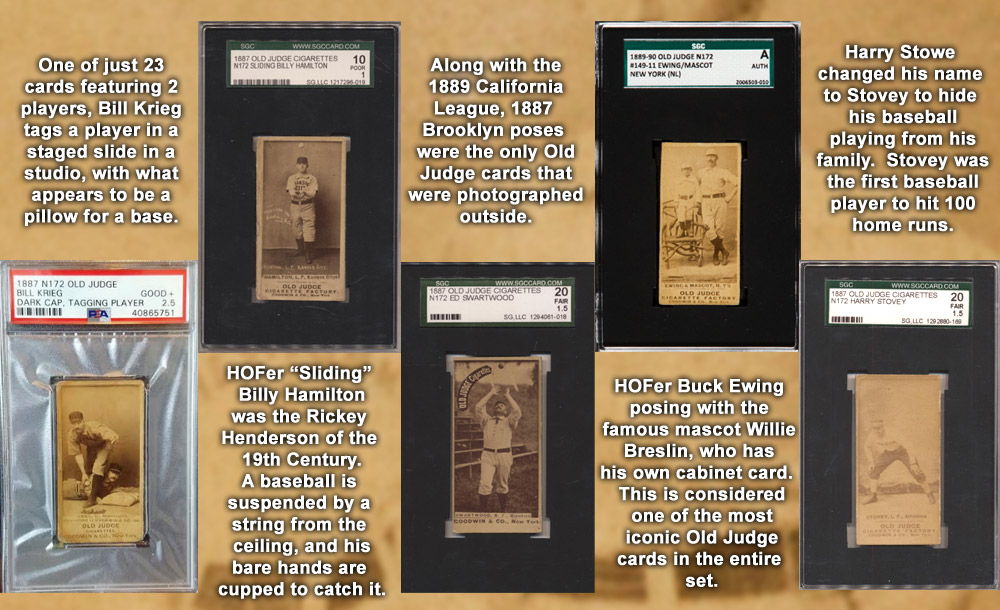
While I had fun with the self-timed camera on my phone and Photoshop to put together some goofy mock cards of myself in under an hour, the production of Old Judge cards was vastly different. What the makers of Old Judge baseball cards would do, is place trimmed down cabinet sized photos of players in a 24 image matrix. Much of the text and labels you see on Old Judge cards were actually glued or pinned directly onto the photographs. Once the 24 image matrix of trimmed down cabinet sized cards were carefully put in place, with all labels and such affixed to each photo, a camera would then be used to photograph the entire panel of 24 photographs. The albumen prints would then be developed (by using egg whites to first coat the paper!), glued to cardboard backing, chopped up and placed in cigarette packages. It is unknown how many of these were created, but this massive set has very few cards in the PSA population report that reach the double digits. It is likely that when multiples of cards were created, it was done by the photographer simply snapping multiple shots of the 24 image matrix, and cutting them down to size.
Much of my Old Judge knowledge comes from researching online, but also from the book “The Photographic Baseball Cards of Goodwin (1886-1890)” – it is a great reference book, and I highly recommend it! There is so much more to learn about this magnificent set.
Speaking of books, the one pictured below is shown next to quite possibly my favorite Old Judge card in my collection. I remember the Billy Sunday book as a child, and always thought that Sunday played in the 50s, due to the book’s artwork looking similar to a 1956 Topps baseball card. To my surprise, I learned over the past year that Billy Sunday was actually a baseball player in the 1800s! His father passed away weeks after his birth in the Civil War. Billy had 5 different poses in the Old Judge set, and the one pictured below is my favorite, thanks to its contrast, suspended ball, artful backdrop and most of all, the fact that it is Billy Sunday.

1887-1888 Allen & Ginter (N28)
Allen & Ginter really stepped up with their offering of the World’s Champions. Featuring full-color lithographs, ten cards portraying baseball players were created, six of which being Hall of Famers, but nearly all having fascinating stories. The beautiful artwork of Allen & Ginter has proven to be timeless. Topps picked up the exact design in 2006, and has been re-issuing it every year since, with minimal changes from year to year, and proves to be a collector favorite year in and year out. It is amazing to me that possibly the first nationally distributed full color set of baseball cards possesses so much beauty, that people still love the design enough to continue collecting nearly 150 years later. You know, kind of like 1991 Fleer (or not!)

One of the coolest things about this set is knowing that its production is wildly different even from T206 cards. They were handmade, meaning the designs on the printing plates were made by hand and hand-held tools. It is incredible to think that these are as much an original work of art as a Rembrandt or Picasso.
A few notes on the set:
It features 10 guys that many may have never heard of, though many were superstars of the game. In fact, if television had been invented, or photography was further along during their careers and could have been easily replicated, these guys would be household names like Babe Ruth and Ty Cobb are today. They certainly were back in the 19th century. Cap Anson (his Allen & Ginter card is quite possibly the most famous and recognizable 19th century baseball card ever made) is what many could be considered to be professional baseball’s first superstar. His Allen & Ginter card is the only card in the set to NOT have the iconic background color splash that the rest of the Allen & Ginter cards have (and virtually all the newer created ones as well.) I am not sure why that is, but would love to know!
If Cap Anson wasn’t professional baseball’s first superstar, then Mike “King” Kelly was. In fact, many would argue this to be true. Nicknamed “The $10,000 Beauty”, King Kelly was given record-breaking money to play baseball. He transcended baseball, and, like Cap Anson, has had books written about him. In addition to this, however, King Kelly also had a song written about him named “Slide, Kelly, Slide” which was America’s first “pop hit”. How many players can say that? There is also speculation that he was perhaps the subject for “Casey at the bat”.

I picked up the Goodwin card of his shown above as well, because like the Allen & Ginter Cap Anson, it is among the most famous 19th Century baseball cards around. The coloring is fantastic with its multi-colored sky and clouds in the background, as well as the mention of Old Judge & Gypsy Queen at the bottom.
Who is this guy, anyway?
Allen & Ginter is one of the first boxes I picked up when I got back into the hobby. While I wasn’t amused with the “game used” duck caller flannel card or bowling shirt card, I thought the cards were extremely nice. The one thing I have always wondered was, who the heck is this creepy looking guy?

I don’t really collect any cards other than baseball, but the one pictured above is an exception. I figured if there was one non-sport card to pick up, the “Old Planter” would be it!
I’m excited to say that I’ve been able to acquire the entire 10 card baseball set, which due to their handmade production, makes me feel like an art aficionado. I need to order a cape and monocle from Amazon ASAP! To this day, it surprises me that many collectors don’t realize that the Topps A&G offering is actually a call back from the legendary set of the 1800s.
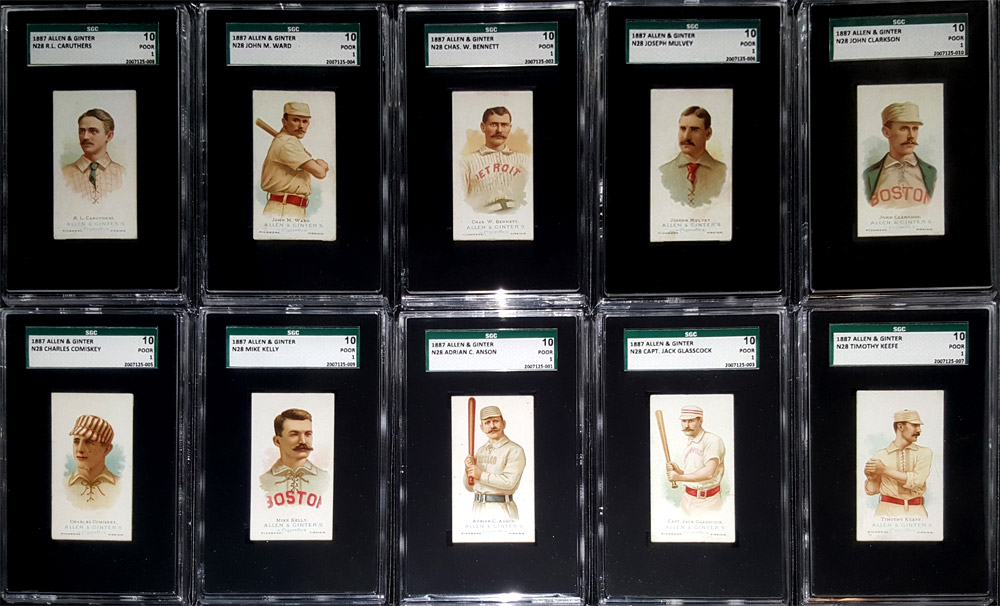
We’ve discussed Cap Anson and King Kelly, but the set is full of other colorful characters.
Fast Facts:
John Montgomery Ward (HOF) – The only man to have over 100 wins as a pitcher and over 2,000 hits. He is credited by many to have developed the curve ball. Officially, Candy Cummings is credited with this in 1867, but perhaps Ward had a hand in throwing it overhand later.
Tim Keefe (HOF) – Among the most dominant pitchers of the 19th century, and was part of arguably the best 19th battery, with Buck Ewing (the dude in the Old Judge card above posing with a child). He was the 2nd ever to record 300 wins, and his first season was the last where pitchers threw from a distance of 45 feet. They then went to 50 feet. Finally, in his last season, they extended it to 60 feet, 6 inches, like it is today. All four of his brothers died in the Civil War, and his father was a POW.
John Clarkson (HOF) – Was sold with King Kelly to Boston, to which they were called “The $20,000 Battery”. First pitcher in history to strike out three batters on nine pitches. During a game that carried into the dusk hours, Clarkson once pitched a lemon to the plate to persuade the umpire, Jack Kerins to call the game due to darkness. Kerins called the lemon a strike, and when shown by Boston’s catcher that he had called a lemon a strike, Kerins finally called the game. In 1905 or 06, Clarkson suffered a breakdown, was declared insane, and was committed to an insane asylum. Clarkson spent much of the next three years in mental hospitals.
Charlie Bennett – Noted by some as the best defensive catcher of the 19th century. Many credit him as the inventor of the chest protector. In 1894, Bennett was joined by John Clarkson (mentioned above) for a hunting trip. On January 10th, he lost both legs in a train accident, ending his career. In 1896, Detroit’s new stadium was named Bennett Park after him.
Joseph Mulvey – Within the first few games of his career, a teammate antagonized a fan by spraying him with a water hose. The fan was enraged, went home to get a gun and came back, attempting to shoot Mulvey’s teammate. His aim was off, and the bullet struck Mulvey instead. He didn’t die, and ended up getting traded shortly thereafter.
R.L. (Bob) Caruthers – Some sources recognize him as having compiled the highest winning percentage of any pitcher with at least 200 decisions (and retired as of 2006) in major league history. Often considered one of the most deserving baseball players for the Hall of Fame that isn’t yet in.
Jack Glasscock – Set many records defensively, and was often near the top for many offensive categories. Nicknamed “Pebbly Jack”, as a shortstop, he would scan the ground for pebbles and place them in his pocket, so balls wouldn’t take bad hops. He played a notable role in defensive tactics, as well.
Charles Comiskey – It is likely that you have heard this name before, even if you haven’t heard any of the others above. Comiskey a founding owner of the Chicago White Sox, also played a hugely significant role in the formation of the American League. The White Sox played in Comiskey Park, a stadium that stood for 80 years, until 1990 and was demolished in 1991. Comiskey gets a lot of flack for the 1919 Black Sox fiasco, but the book “Turning the Black Sox White” the author argues that perhaps much of the myth around Comiskey’s miserly ways were unfounded noting that any role he had at all in the scandal is unsubstantiated.
Where did all the baseball cards go?
After about 1890, production of baseball cards had seemingly vanished. The American Tobacco Company (ATC) had formed, and since there was no longer any competition, the need for advertising with baseball cards ceased to exist. This was a sigh of relief to many cigarette makers, as the high costs associated with producing cards would cut into their profits.
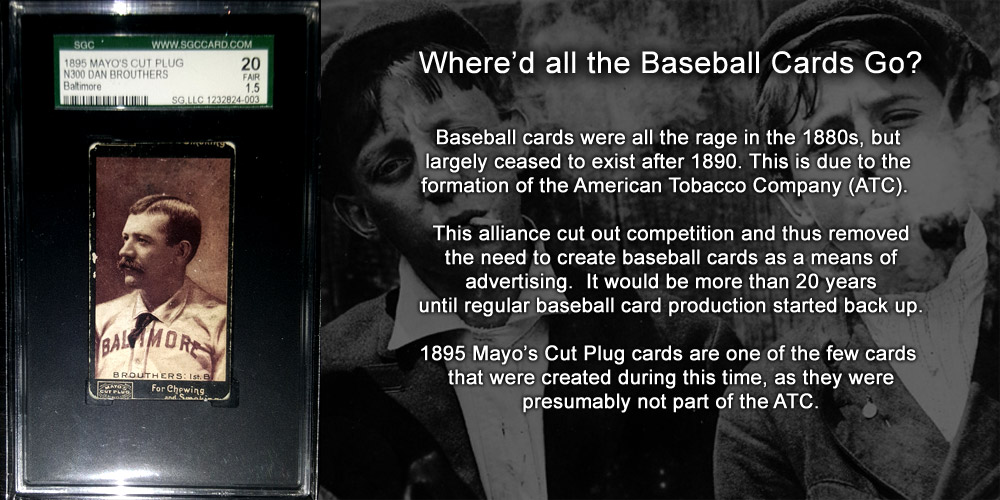
Mayo’s Cut Plug was one of the few companies that put out cards from between 1891 and 1908, and did so presumably because they were not a part of the ATC. If you think 1971 Topps or even 1985 Donruss were difficult issues to find cards with decent black borders, think again. 1895 Mayo’s Cut Plug tells ’71 Topps “hold my beer, youngster, and watch this.” Thus far, the lone example I have in my collection is of the card shown above, which I picked because of the player selection and highly presentable picture.
For those who don’t know who Dan Brouthers is, take note. He is considered to be our national pastime’s first great slugger. Nicknamed “Big Dan”, Brouthers was 6’2″ and 207 pounds. While that isn’t big by today’s standards, the average height for a male in America during this time was 5’6″! I don’t know what they are putting in the water these days, but that’s pretty incredible in and of itself. Before he made a major league appearance, Brouthers played a game where he collided at home plate, knocking the catcher out, which caused the catcher to suffer a traumatic brain injury. The catcher later died because of the collision.
The Early 20th Century welcomes back baseball cards
With no reason to advertise thanks to the American Tobacco Company monopoly, very few cards between 1890 and 1909 were created. That all changed, when the ATC was broken up. Around this time, cards such as the popular T206 set came into existence.
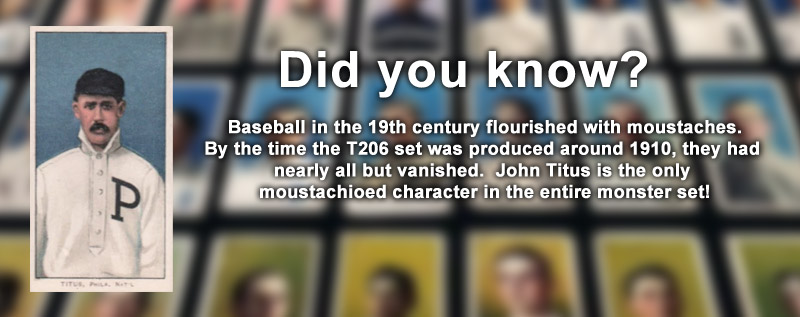
I have loved T206 cards ever since I was a child. When I was 12 or so, I remember saving up as much money as I could to purchase 25 T206 common beaters via mail order from Kit Young (yes, I am “Ordered cards from Kit Young via Mail Order” Years Old!) just so I could have some semblance of owning baseball history. Though they were in absolutely horrific shape and the players were nobody anyone heard of, it was a treat to own cards that were 82 years old (and now 109 years old!) When I got engaged several years later, I ended up selling them on eBay for very little money just so I could have enough money to buy my fiance (and now wife) something nice for Christmas. I have never regretted that, because she is totally worth it, but it is never fun to have to sell cards when you don’t want to. I don’t think he was in the lot, but it sure was fun putting together a custom for a guy who is related to someone in the T206 set. Pictured below is a jumbo cabinet cut signature custom I put together a while ago. I’ve shown it before, but figured it would work nicely showing it here again.
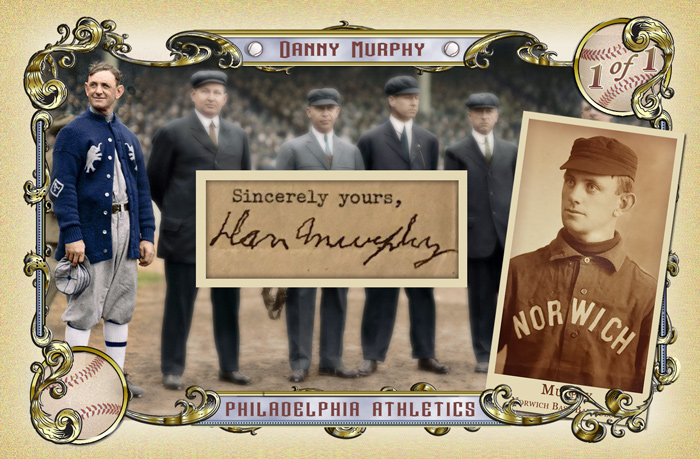
Simply put, T206 cards are works of art. Each piece has incredible detail, and many have beautiful coloring. Now that I’m finally back into vintage, I have been able to add a few to my collection. Unlike the guys I ordered from a Kit Young mail-order catalog, I have heard of these guys before. Shown below are my favorite 20th century T206 cards. Well, okay…a T205 Gold border is included as well. What can I say? I’m a sucker for Matty’s bangs.
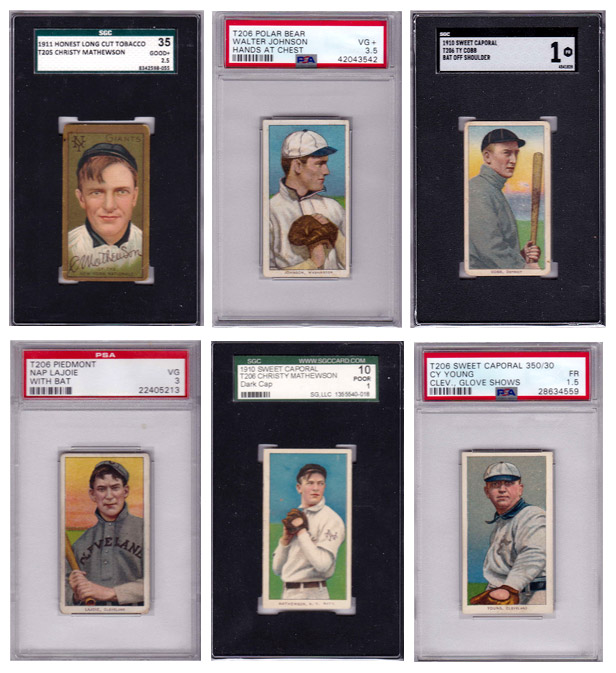
Within this block of six cards are the first players of the 20th century to be considered baseball royalty. Denton True Young was nicknamed Cy, short for Cyrus, because everyone thought he was a country bumpkin. Later, it changed to Cyclone, because of his devastating feats on the mound. Compiling an untouchable 511 wins, it’s no mystery why baseball’s most prestigious pitching award has been named after him, making him the best pitcher in baseball history.
Or is it Christy Mathewson?
Nicknamed the Christian Gentleman, Mathewson’s clean living was contrary to the majority of how other ball players lived. A true role model, handsome and intelligent, Mathewson might be considered what Mike Trout is today. Much like Billy Sunday from the previous century, Mathewson refused to pitch or play on Sundays. He served in World War I, and was exposed to poison gas, causing him to be highly susceptible to tuberculosis. Shortly thereafter, he died. Mathewson compiled unbelievable statistics and is definitely the best pitcher in baseball history.
Or is it Walter Johnson?
Nicknamed “The Big Train”, Walter Johnson had devastating stuff on the mound and put together quite possibly the greatest statistics a pitcher could ever hope for. Don’t take my word for it, though. Check out what Ty Cobb had to say about him:
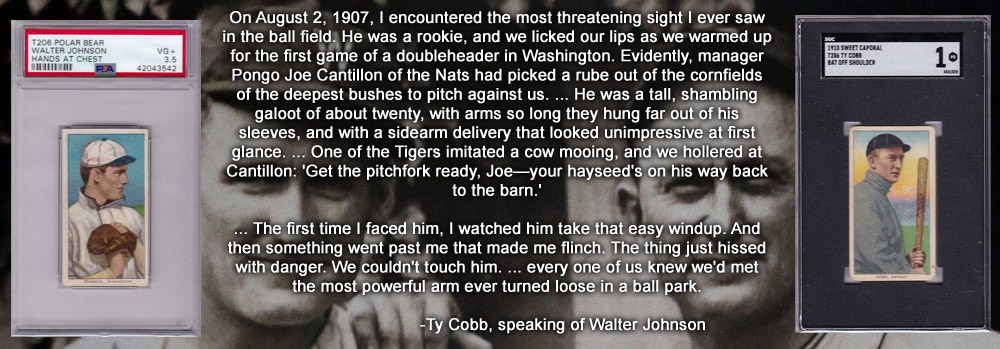
Not many pitchers can say they struck fear in the best batters in baseball, especially Ty Cobb.
Speaking of Cobb, one could write books about his exploits. Some consider him to be the best player in history. When he retired, he held over 90 records and still holds the record for highest batting average. Cobb was the first member of the Hall of Fame. Up until recently, the entirety of baseball fandom took him as a simply wretched person. Evidence has come to light in recent years that perhaps Cobb’s legacy was treated to a maligning like no other. There is no doubt that Cobb was aggressive, crass and would do anything to win, but it is quite possible that a lot of rumors about who he was, what he believed and what he engaged in are simply false.
The Cobb card shown above is my favorite Cobb in the T206 set. The beautiful colors represented and the determination he shows while gripping his bat make for an extremely attractive card.
The last player in the block of Tobacco cards shown above is who I would consider to be quite possibly one of the most underrated superstars from the turn of the century. Napoleon Lajoie (pronounced Lah-jzhoo-way, or La-jzhoo-wah, or Lah-jzhwah or…) was the first superstar of the American league, and was often neck & neck with Ty Cobb from year to year in various hitting statistics.
A bizarre batting race
In 1910, the Chalmers car company offered a brand new automobile to the batting title winner. Cobb thought he already won and sat out the last two games, claiming an eye ailment. Meanwhile, Lajoie was determined to win, and noticed his opponent’s third baseman playing unusually deep. The opposing team’s manager (a former member of the Cleveland Spiders) told his third baseman to play back, or else one of Lajoie’s line drives might kill him. It has also been said that the manager may have just hated Cobb so much, that he called for that configuration. Lajoie dropped down 6 bunts, for 6 hits. Eventually, he went 8 for 9, including a triple and infield single.
The next day, news outlets were reporting Lajoie had won, much to the delight of many. Even 8 of Cobb’s teammates sent a telegram congratulating him. When the official tally was recorded, the stats showed the it was actually Ty Cobb who had won the batting race by .000974 of a percentage point. Chalmers made the decision to award both players with a brand new car. Was this a smart PR move, or did Chalmers simply like Lajoie more? Lajoie said: “I’ve always understood, that the automobile I got ran a lot better than the one they gave to Ty.”

Over 70 years later, Sporting News historian Paul MacFarlane discovered that Ty Cobb was mistakenly credited with two more hits than he should have, which would have made Lajoie the clear winner.
Napoleon Lajoie was loved by many, and seen as a hero. For a time, he was Cleveland’s manager while he played and the team actually renamed themselves to the Naps, because he was loved so much by Cleveland. During the time that the team was named the Naps, the great Cy Young and Shoeless Joe Jackson played under him. Napoleon Lajoie was truly a remarkable player who may have been much better, had he not divided his attention to managing the team. He was quoted as saying being a manager was the biggest mistake of his career, as he felt it negatively affected his play.
With as incredible as Lajoie was, it is hard for your light to shine brightly when Ty Cobb is playing. From 1907 to 1919, Cobb won 12 batting titles. As he was such a force in baseball history, I made him my focus of a couple other baseball card examples that I wanted.
First, the T202 Hassan Triple folder.
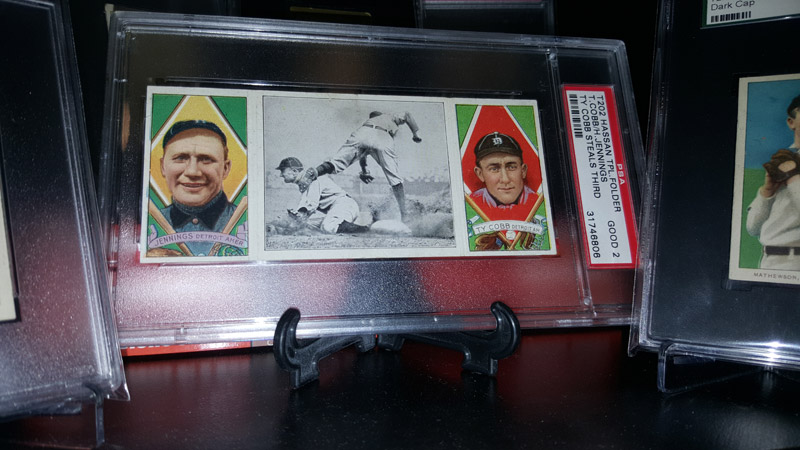
This card features an innovative design that allowed for both ends of it to be folded in, so that way it could fit in its box. This particular card features hall of famers on both sides, with one being Ty Cobb, of course. Perhaps the best thing about the entire card, is the action shot shown in the middle. If this picture looks familiar, it is probably because it is considered by many to be the most famous action shot in all of baseball history. In fact, a type 1 photograph of it recently fetched $250,000 at auction.
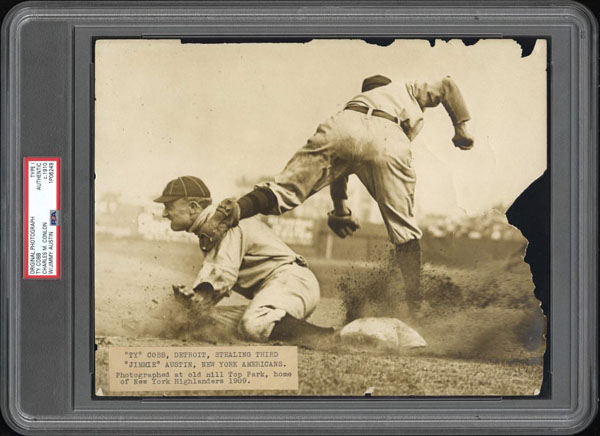
The photo was taken by renowned photographer Charles Conlon. What’s amazing is that Conlon didn’t even know he took the picture. He was speaking with Austin, the third baseman when Ty Cobb came in hard with his teeth clenched and spikes flying. Conlon, being friends with Austin, was worried that he may have been injured. On his trip back, Conlon said he wished he had taken the photo, and just in case, he changed plates. When he developed them, he was delighted to find that he did instinctively take the photo, which became perhaps the most popular photograph in baseball history – and he didn’t even know it. The T202 Hassan Triple Folder that features the photograph is the only card that I know that features it.
My final Ty Cobb card to show is my favorite. It is a T3 Turkey Red, which is a cabinet card. Collectors could send in coupons from cigarette boxes and obtain these. They are significantly larger than regular cards, and are absolutely beautiful works of art. You can keep the Mona Lisa – I’m taking the T3 Turkey Red Cobb! Pictured below is my Cobb Turkey Red along with my Cracker Jack cards of Napoleon Lajoie, and hall of famer Tris Speaker. (I LOVE Cracker Jack cards!) Like Lajoie, Tris Speaker is a player whom I would consider to be vastly underrated by today’s casual fan and is definitely worthy of the baseball royalty title.
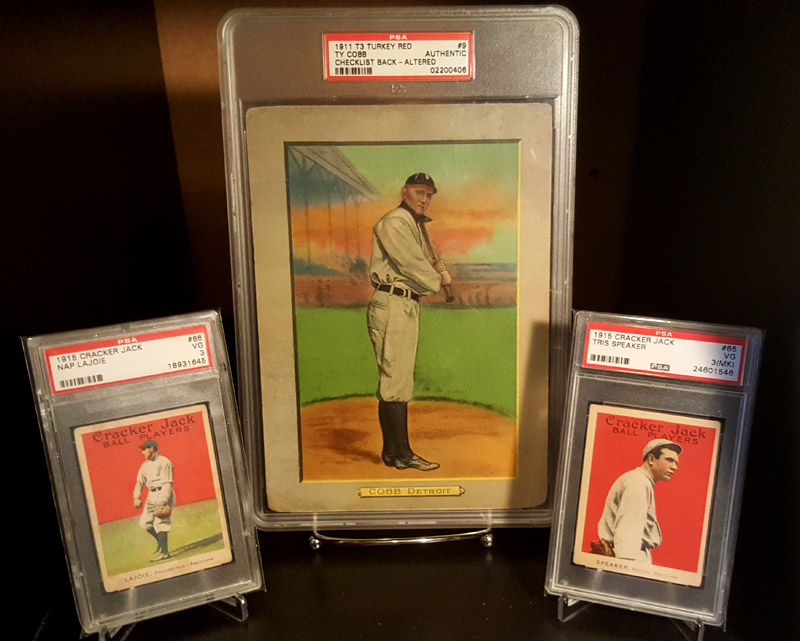
If you are keeping score at home, there is one notable superstar of the early 20th century that is missing. Can you guess who? I’ll give you a hint: He was considered by many to be the best in the game. His name starts with an “H” and ends with “onus Wagner”. The man who’s T206 card has sold for millions of dollars. Sadly, I don’t have millions of dollars to throw aro….well actually, I just don’t have millions of dollars. What I do have however, are a couple cards that excite me to no end.
Tobacco companies weren’t the only ones creating cards during this time period (as shown by the 1915 Cracker Jack cards above.) Candy makers, Newspapers, and others were as well. I’m thankful they did, because without them, I would not have been able to add the next two cards.
It is generally accepted that the E102 set predates the T206 Wagner, which is cool in and of itself. Its stark red background with Wagner at bat is simply striking. As with most of my cards, this one in particular looks much better than the numerical grade it was assigned. As a bonus, being from 1909, it hold extra significance as Honus Wagner and Ty Cobb went head to head in the World Series. As the legend goes, when Cobb first reached base, he yelled over to Wagner, calling him “Krauthead” and that he was coming to steal second. As Cobb attempted it, not only was he thrown out, Wagner tagged him so hard on his face, it busted his lip. That seemed to set the tone for the rest of the series, with Wagner demolishing Cobb in nearly every statistical category.

Does the name Carl Horner ring a bell to you? If not, let me tell you about him. He was a photographer that took portait pictures of many baseball players, that have been used on various baseball cards newspaper articles and more. His work has been featured in the T206 set, Cracker Jack and many others. He is most famous of course, for taking this photograph of Honus Wagner, somewhere between 1902 and 1905.
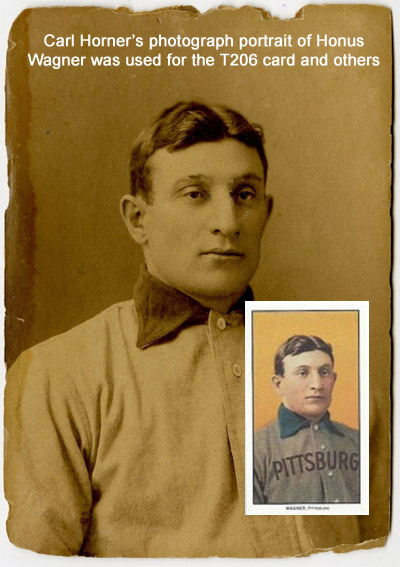
What many do not know is that this iconic photograph wasn’t used just for Wagner’s T206 card. It was used for a few others as well, including the 1910-11 Sporting Life M116 card. I have been extremely fortunate to have landed one, shown below! It is hauntingly beautiful, with its multi-colored background and Wagner’s rosy cheeks. Owning an authentic Honus Wagner of the same age and same portrait as the T206 is a dream come true!
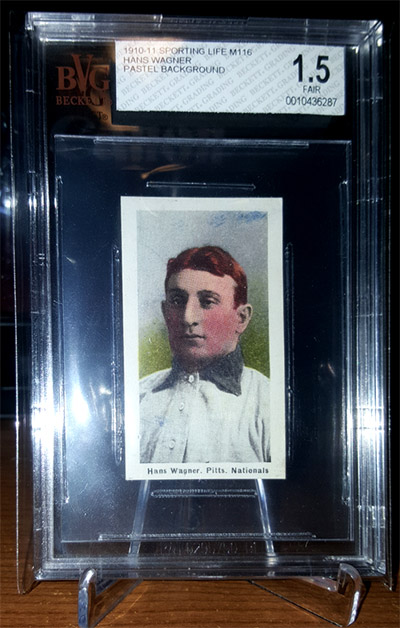
Not again! Where’d the beautiful baseball cards go?
When World War 1 came into focus, and with it, America’s involvement, Tobacco cards ceased to exist again. Candy and gum cards were still produced, yet were severely lacking from an aesthetic perspective. Throughout the last 1910s and 1920s, the majority of baseball card offerings were either black & white or what appeared to be primitive looking drawings with simplistic coloring. It wouldn’t be until the 1930s that baseball fans were treated to a major release of baseball cards that could rival the beauty of those created decades prior.
With full color cards coming back into full swing, the superstars of the era were extremely popular.
Nicknamed “The Rajah”, Rogers Hornsby is regarded as one of the best hitters in baseball history, having a career batting average second only to Ty Cobb. He has two triple crowns under his belt and is the only player to hit 40 home runs and hit .400 in the same season. Hornsby was a difficult man to get along with, and his teammates didn’t like him much, but he was considered a dominant player in his era.

Did you know that Germany made sports cards? In 1932, Sanella Margarine created a sports card set on thin, large stock, with one of the subjects being baseball’s #1 household name, Babe Ruth. If you were to ask anyone on the street the name of a baseball player, they will undoubtedly speak the name of Babe Ruth, while becoming tongue-tied while attempting to name another player. It is amazing that even back then, he not only transcended the game of baseball, but also America. The back of this card features all German text, and the front is extremely beautiful. It is great being able to own a piece of baseball history from Germany during an incredibly tumultuous time for their country. Nicknamed “Hitler’s Butter Card” (okay, no it isn’t), if you want a beautiful Babe Ruth card produced during his playing days that pre-dates his Goudey, this is an extremely affordable option. These can often be picked up for a couple hundred dollars or less.
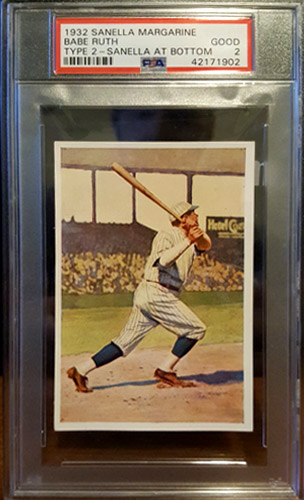
We all know about Babe Ruth, but how about the right handed Babe Ruth? Jimmie Foxx was nicknamed “The Beast” or “Double X”. He was an incredibly strong man and would have tied Babe Ruth’s then single season home run record of 60, except two home runs he hit were in rained out games. Lefty Gomez once said “He has muscles in his hair”. Like Ruth, Foxx was also a dominant pitcher, if only for a small amount of time, compiling a 1-0 record with a 1.59 ERA in 9 games. Ruth had significantly more time as a pitcher at the beginning of his career, but Foxx pitched at the end of his. This 1933 DeLong issue is among his most popular cards ever.
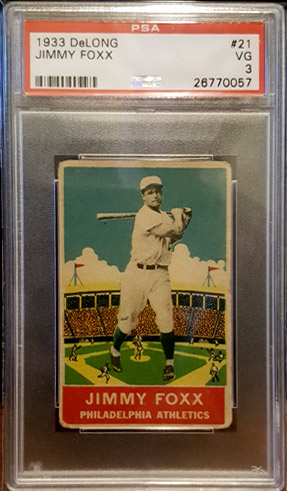
To wrap up the cards in the 1930s, I went with a few big-time cards of Yankee legends. From left to right, you have arguably the most famous and recognizable cards from Lou Gehrig, Babe Ruth and Joe DiMaggio. If you have seen baseball cards from any of these guys, the odds are that these cards are the ones that pop in your head first. They have dawned the covers of more magazines and price guides over the past several decades than can be counted.
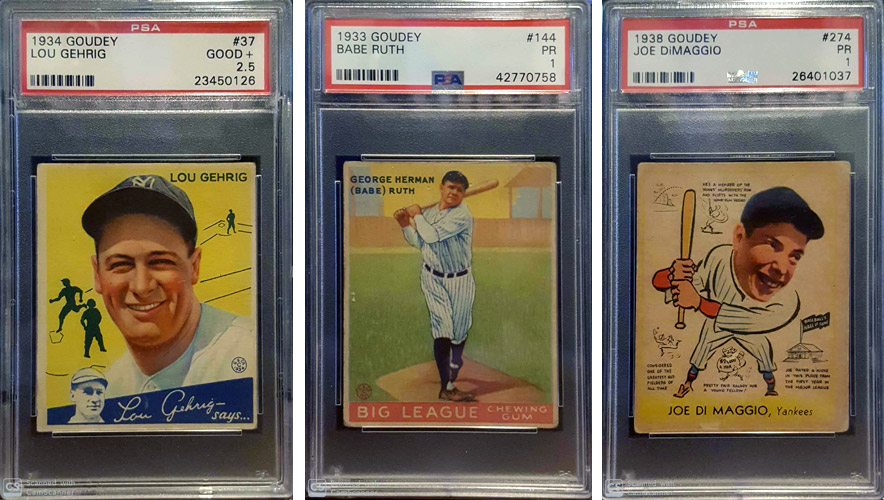
The next and final time period I’ll cover with my pickups will be the 1940s and 50s. With both world wars behind us and the country booming, this is really when baseball cards started to ramp up. This time period also ushered in one of the richest eras of baseball heroes, ever.
The 1953 Topps portaits of Jackie Robinson and Satchel Paige are among my favorite cards in one of the most beautiful sets Topps has ever produced. I LOVE the Brooklyn bridge behind Jackie.
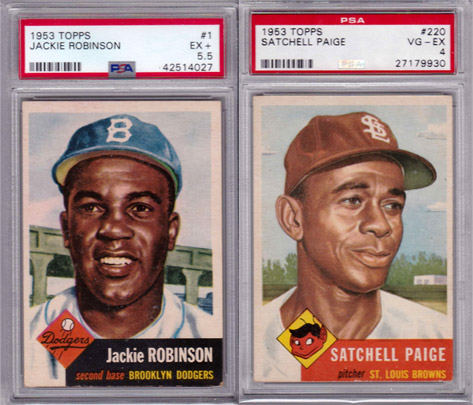
Going beyond that, I decided to go big and pick up rookies of Jackie Robinson, Satchel Paige, Hank Aaron, Roberto Clemente and Willie Mays.
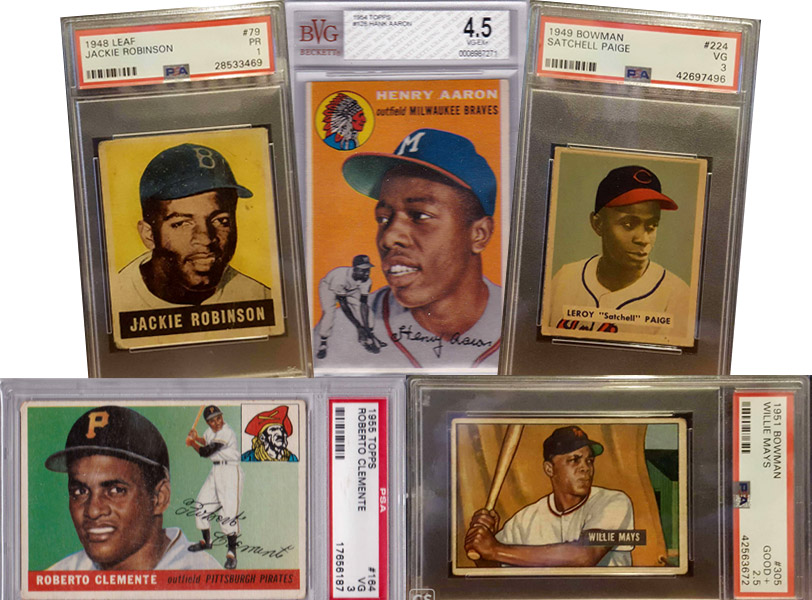
But wait, there’s more! As a child, I was ecstatic if I would ever run across beat up commons from the 1952 Topps set. It would give me chills just knowing that they were in the same set as the famed Mickey Mantle card. I even wrote about it in my book … see?

By now, many people have read about how Topps had an unreal amount of unopened cases of the last series of 1952 Topps in their warehouse for a decade, and couldn’t give the stuff away. Eventually, they made the decision to dump them in the Atlantic, making them much tougher to find than the others.
The last card I have to show is the reason the story above is such a big deal. It isn’t perfect, but it is the most popular baseball card in post-war history. Here it is, my Mickey Mantle:
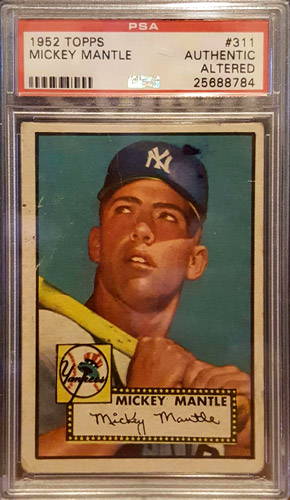
Never in my wildest dreams did I ever think I would own this card, or frankly any of the others, for that matter! It all started with letting go of supercollecting. This adventure was wildly different. There was no stress, and no compulsive worrying about missing out on anything. Emotionally charged interests in any cards were tempered with level-headed, rational decision making when it came to purchasing. That is an extremely difficult thing to do as a supercollector when you go after 1/1s!
My mindset was mainly geared toward not just collecting, but investing – and telling a story through my new collection. It is my hope that it has done just that for everyone reading. *None* of these cards are going to the grave with me. In fact, they may gone tomorrow, in part or in totality. This journey was about obtaining and owning them, but make no mistake, while I am passionate about them and the story they tell, they are investments. In spite of whatever negativity is going on about graded cards today, I am a strong believer that vintage cards of key hall of famers are a safe investment, particularly those in a low grade with exceptional eye appeal. I am always open to buying, selling, trading or upgrading.
I have also picked up a few modern cards as well. These aren’t all of them, but they are some of my favorites.
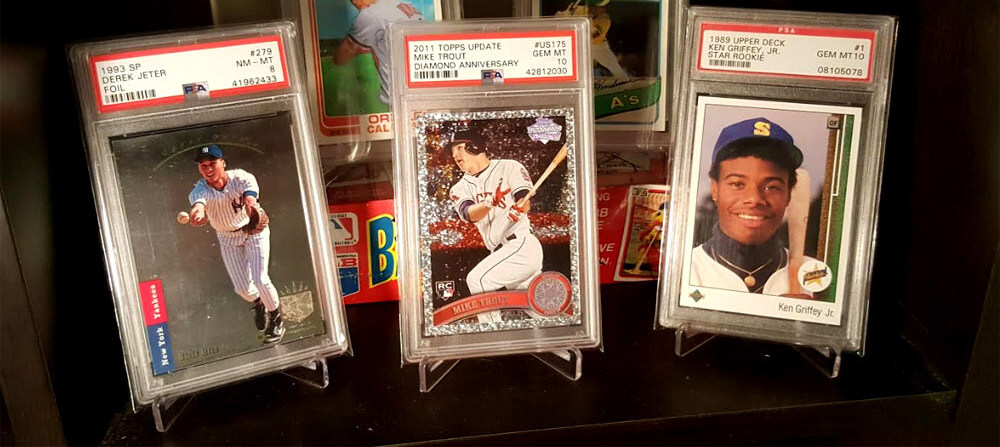
What about Canseco?
Last, but not least, I still do have some Canseco cards and continue to pick up some from time to time that catch my eye – especially if they are extremely rare and special. I still might get more excited about landing a special Canseco card than I do with anything else! It is just no longer my goal to get anything and everything. This year has been a fantastic learning experience for me, and has further confirmed for me that you don’t need to buy every single card you don’t have in any niche for enjoyment.
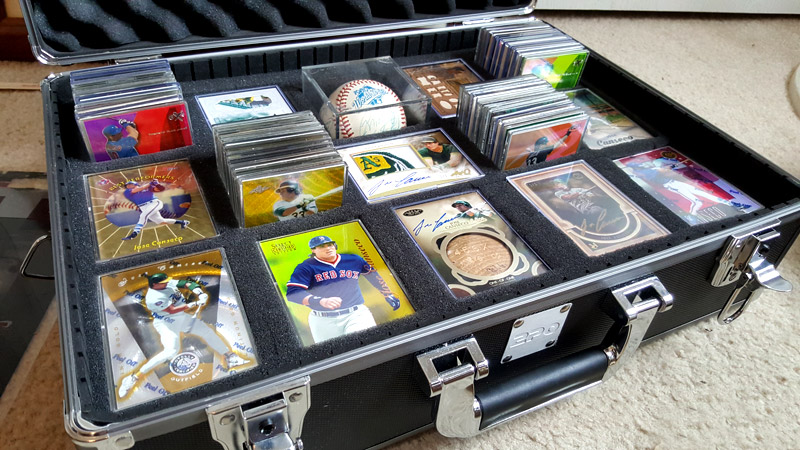
Before these cards go back to the bank, I wanted to take a few final shots of everything together:
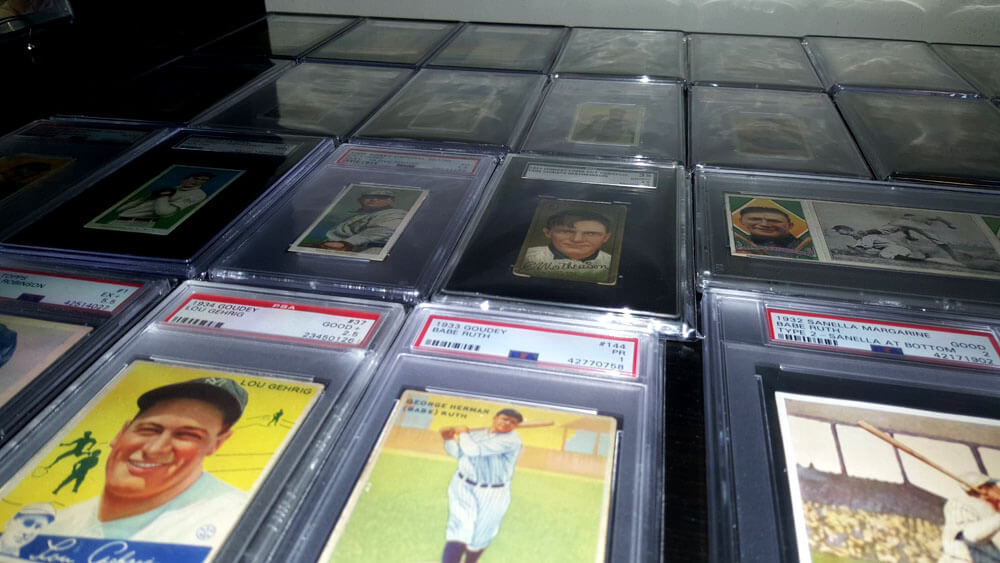
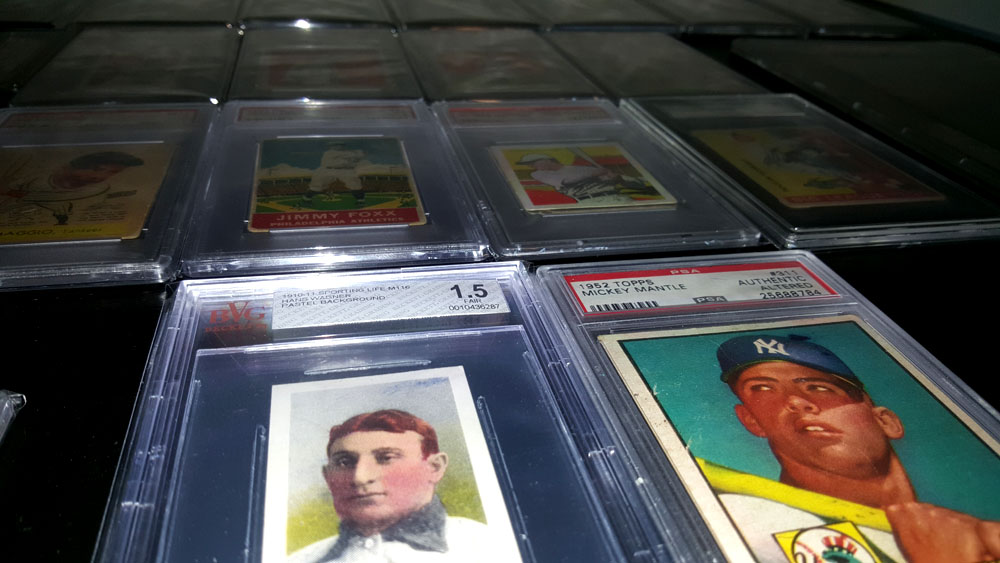
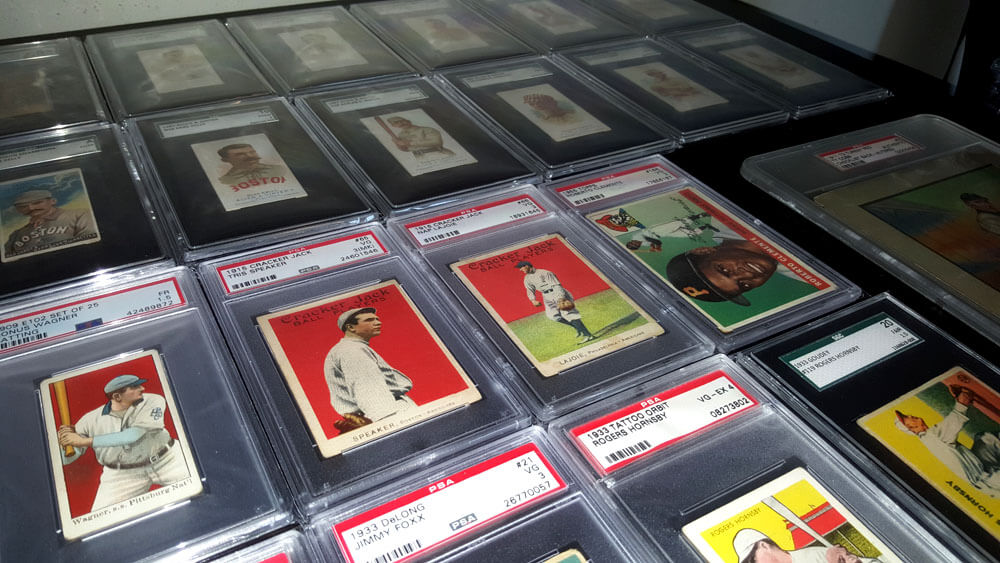
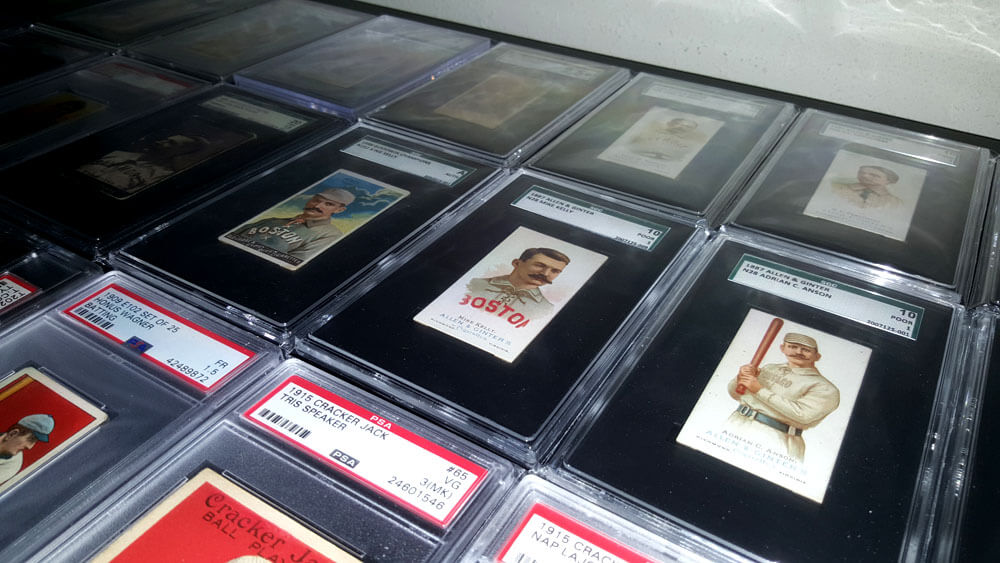
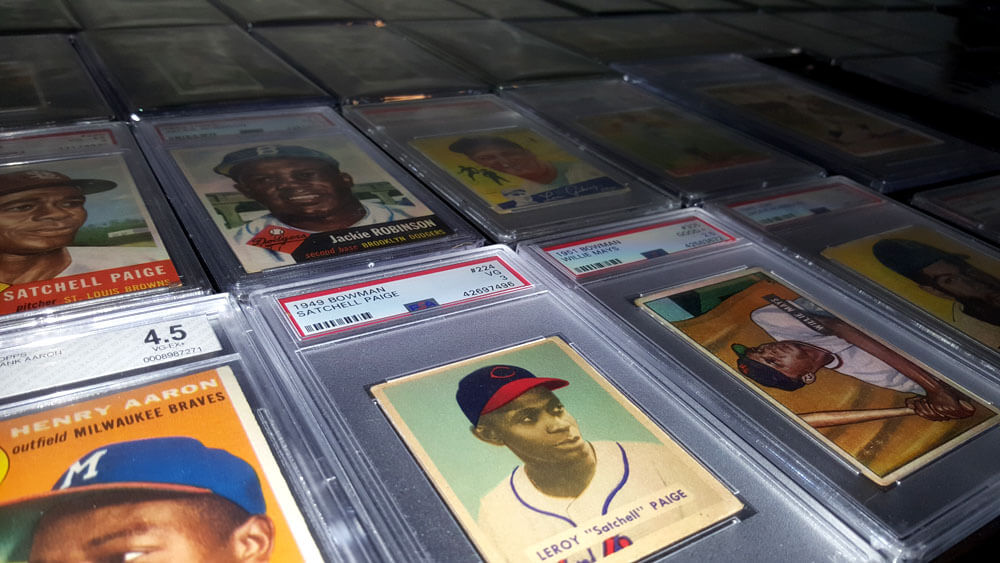
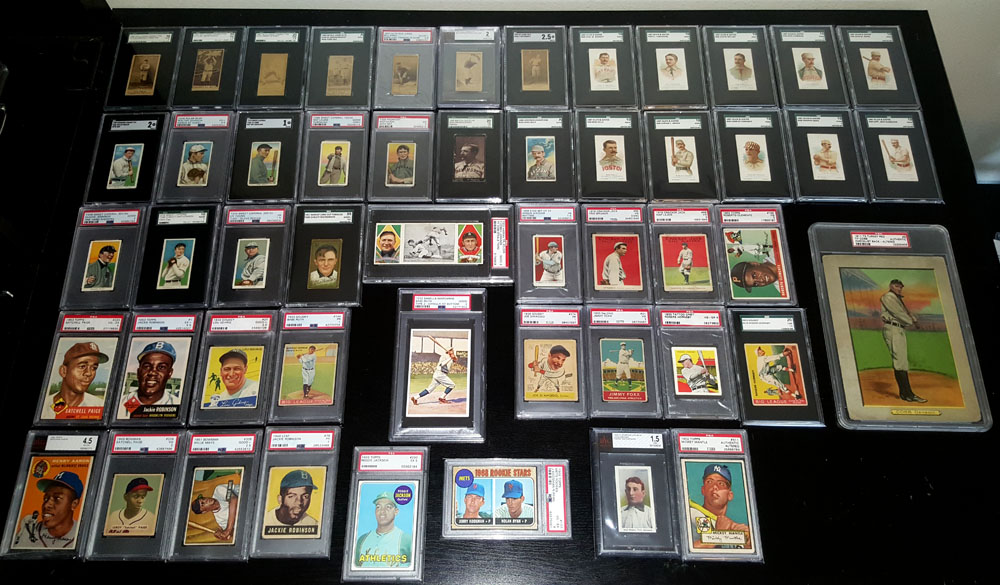
Thank you guys for reading! I hope you have found this to be both entertaining and educational.

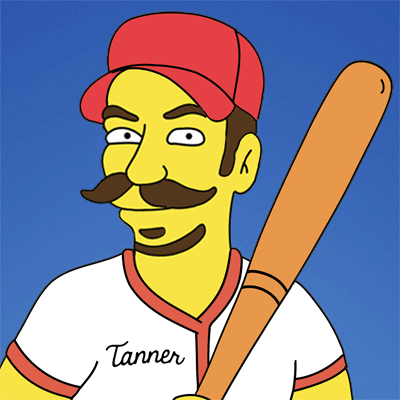

Excellent article, great read! I’m a Sammy Sosa super collector and am making a similar transition to vintage cards.
Thanks Justin! Best of luck to you on your vintage transition!
Tanner
I not only enjoyed your article but I also learned much about the history of cards. My family was in the tobacco warehouse business for probably 40 years before companies went a different direction. This is where I first learned of tobacco companies distributing cards.
I’m 51 today and was about 25 back then and I have been collecting off and on for 30 to 35 years of my life. I started when I was 8 but the late 80’s and 90’s caused me to lose interest – among other things. I picked it back up in about 2011 or 2012. I’ve really been into it concentrating on Trea Turner. After a couple hundred autos and many inserts later I have learned a huge lesson. It shouldn’t have been like a chore but collecting the cards (of anyone) I liked.
I learned more in your story than i had ever known about vintage cards. I’m convinced now it’s a direction I’d like to go soon.
Well, that is when I’m not grabbing up Mackenzie Gore cards. I guess it’s a thing about playing baseball in NC with Turner & Gore. I do have a closer feel to Gore though. How did you ever contact Canseco and did you write him? My daughter is already a friend of Gores so I don’t have a problem with getting any cards really. It’s just other autos from him and the personal contact I kinda wanted. I guess you know more than anybody. However I’ve never read the whole story about you and your collection of Canseco. I just heard of you about a year ago in groups on Facebook
Hi Linwood! I’m sorry for taking so long to write and approve this comment – I didn’t realize it was here until just now. If you go here: https://tanmanbaseballfan.com/2015/05/chasing-canseco-best-day-ever-2.html it will tell you more about my story … plus, my book, Confessions of a Baseball Card Addict talks about everything as well 🙂
This article legitimately brought tears to my eyes.. Baseball is the most beautiful sport in the world, I love it so much.
Thanks for writing, Jordan! As you can tell, I love baseball so much too 🙂